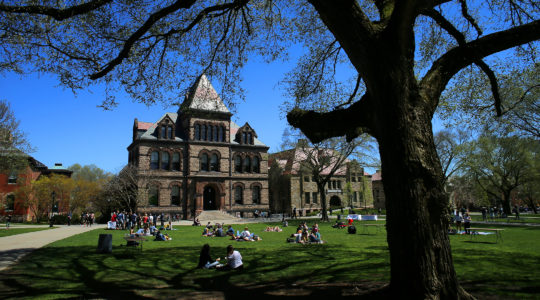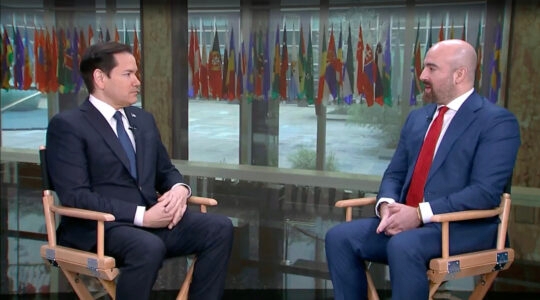At this point in the contemporary Jewish conversation, I’m pleased that most community leaders and members recognize that arts and culture play a meaningful role in our individual and communal lives. And increasingly we understand that contemporary art comes from people who draw from their visions to create the object, image, concept or creative work.
 At the Six Points Fellowship, we are committed to supporting the creation of new Jewish arts and culture, and the human being who makes it and who needs to eat, live, learn and be inspired. We do that for a limited number of extremely talented emerging artists through funding, professional development, Jewish learning, retreats and the creation of a community of fellows. The work that came from our pilot cohort was of high artistic quality and rich Jewish content, and it received very positive critical and audience reception. We see how investing in people and projects, and supporting that development, is a successful model.
At the Six Points Fellowship, we are committed to supporting the creation of new Jewish arts and culture, and the human being who makes it and who needs to eat, live, learn and be inspired. We do that for a limited number of extremely talented emerging artists through funding, professional development, Jewish learning, retreats and the creation of a community of fellows. The work that came from our pilot cohort was of high artistic quality and rich Jewish content, and it received very positive critical and audience reception. We see how investing in people and projects, and supporting that development, is a successful model.
What we don’t do, and I’ve heard so many requests for over the years, is provide a physical space for artists to work and create. I have a vision of a Jewish Artists Residency where there is community, opportunities for learning, space for solitary practice, and an environment that nurtures the creative process free of interruptions and distractions.
I’d like to advocate for the residency happening outside of a city environment, even though the urban jungle is where we generally find both Jewish and artistic concentrations. Getting out into nature is viewed, for Jews and artists, as a way of opening to new experiences and insights. I envision a multi-disciplinary group of multi-generational artists gathering for communal meals and sharing their lives and work in the evenings. Working uninterrupted, and for at least their time in the residency, they would be free of the constraints of the art world and the hum and pull of the everyday. The place could be infused with Jewish values, be home to a Jewish scholar-in-residence, and have a staff that could serve as artistic and Jewish resources.
Like the most influential and important artist residencies, such as Yaddo, Skowhegan and the MacDowell Colony, artists must be working professionally and would be admitted based on artistic excellence and promise. Much of the work that has had a profound impact on contemporary culture has been nurtured in these places through residencies by artists such as Leonard Bernstein, Aaron Copland, Michael Chabon, Meredith Monk, Helene Aylon, Saul Bellow, Phillip Roth, Howard Nemerov, Stanley Kunitz and Bernard Malamud. Imagine what might have happened at a Jewish residency with all of those acclaimed Jewish artists.
In the past few years, I’ve talked with a number of different types of Jewish institutions that have been interested in creating artist residencies. We’ve talked, brainstormed, and created preliminary plans and budgets, but few programs grew out of the conversations.
In reflecting on those processes, I’ve realized that there has been a fundamental misunderstanding around the creation of art and its role in our community. We all agree that art is a powerful way for people, young and old, to connect to Jewish identity and ideas, and can be a useful and meaningful part of an educational process. These uses are a second step to the creative process, not a parallel track. To have high-quality, appealing art to use as engagement tools, we need to create the time and space for artists to create their work.
In general, these organizations have been seeking teaching artists to serve and teach their audiences, campers and participants, and seeing a residency as a kind of barter. I support giving artists jobs and paying them as educators to share their vision and work, but this route is not generative to the creative process. It can feed the artists (in a literal sense) and potentially free up time when they don’t have to wait tables, but high-quality, deeply researched and felt work cannot effectively be created when an artist has to teach twice a day or entertain visitors to the studio whenever anyone happens by.
We already have many physical spaces in our communities that could work for such as program — places like Brandeis-Bardin Institute and Eden Village, or the network of summer camps that have studios, facilities, housing, kitchens. Many of the residency programs in the Northeast started as a summer estate of someone dedicated to supporting the artistic process; there must be a beautiful home on some wooded grounds somewhere that is waiting to be bequeathed to support the future of Jewish culture. Artists could come for three weeks to three months with their living expenses covered, with a commitment to work, and be part of a creative Jewish community.
I wholeheartedly believe in the notion of contributing to a community that supports you, but we need to approach this type of project with the idea that we will provide the artist with a residency and their communal contribution may be less direct or immediately obvious. The creative process is complex, and ultimately the artists’ contribution is the way that their work allows us to discover new things about ourselves and the Jewish community, and create a meaningful dialogue around Jewish life for the future.
(Rebecca Guber is the director of the Six Points Fellowship, a partnership of Avoda Arts, Foundation for Jewish Culture, and JDub Records, with significant support from UJA-Federation of New York. Visit Jewschool.com to read "Idea # 7: Central game portal for teaching Hebrew" and Jewcy.com on Tuesday to check out Idea #9. You can also visit 28days28ideas.com for the full list of ideas as they progress.)
JTA has documented Jewish history in real-time for over a century. Keep our journalism strong by joining us in supporting independent, award-winning reporting.





